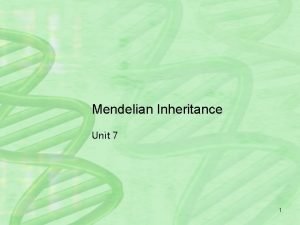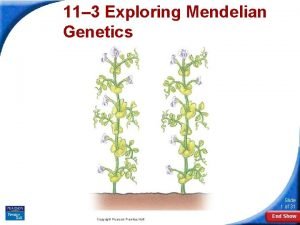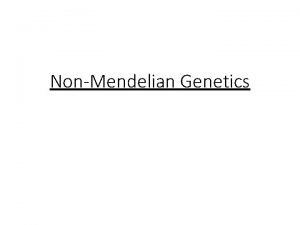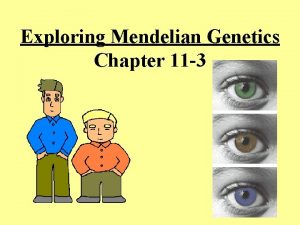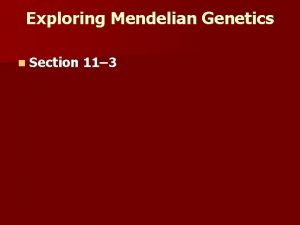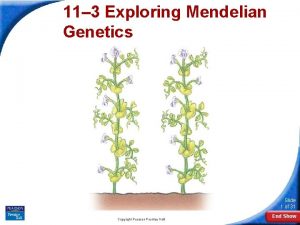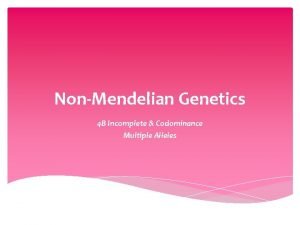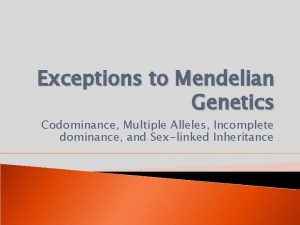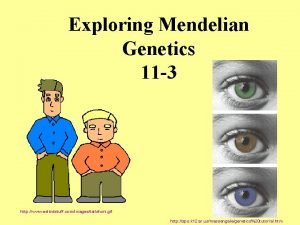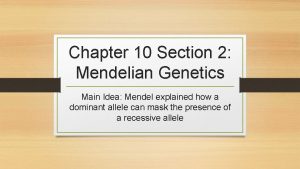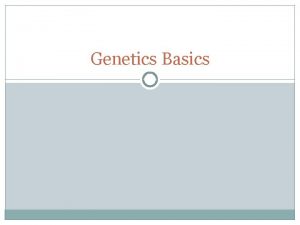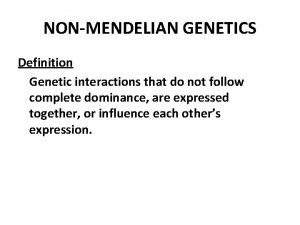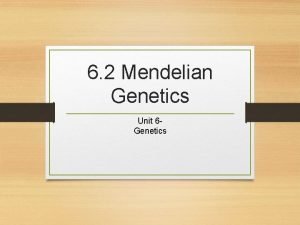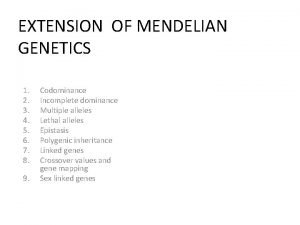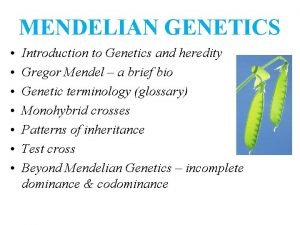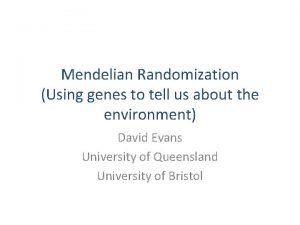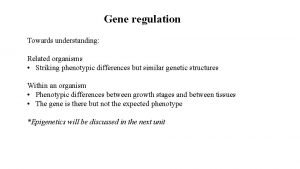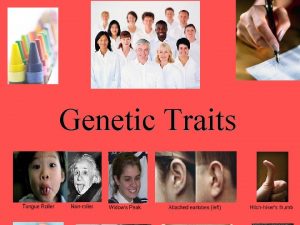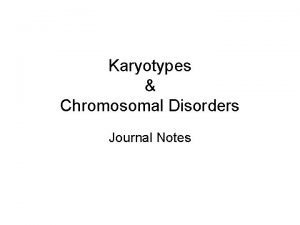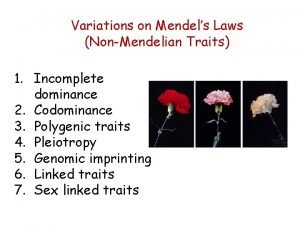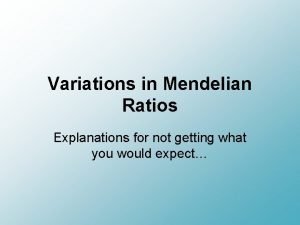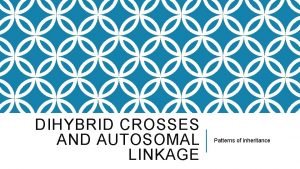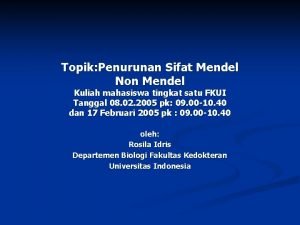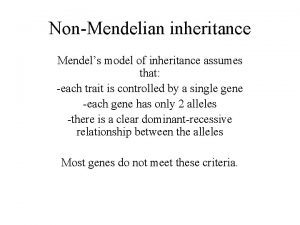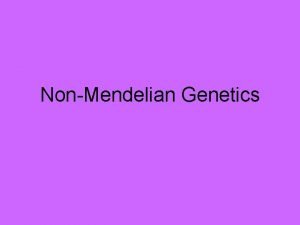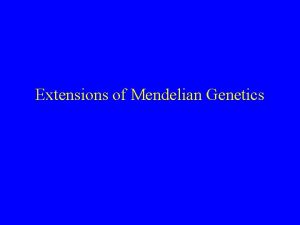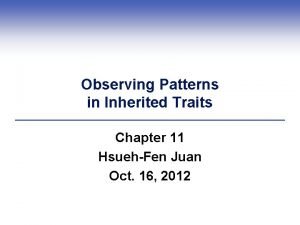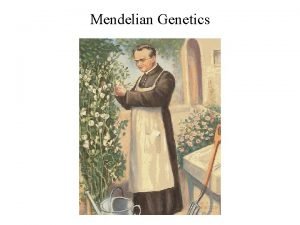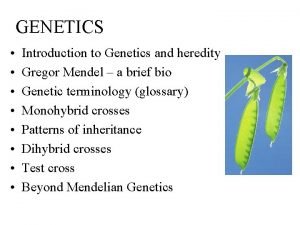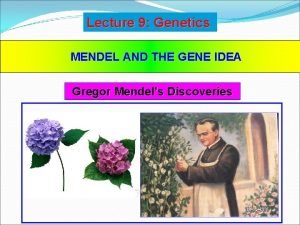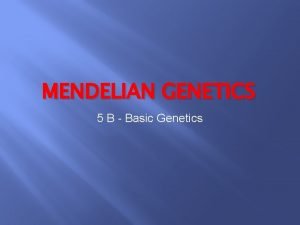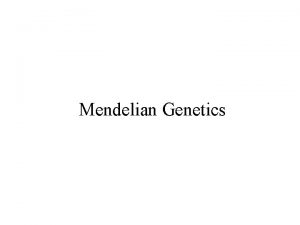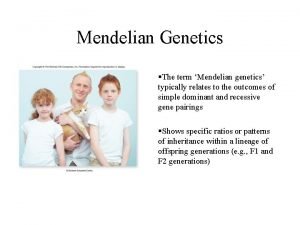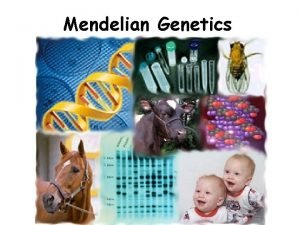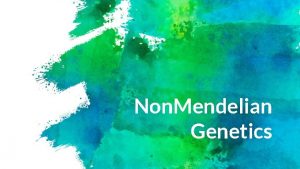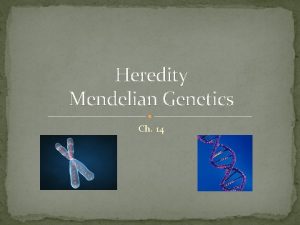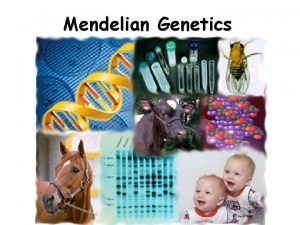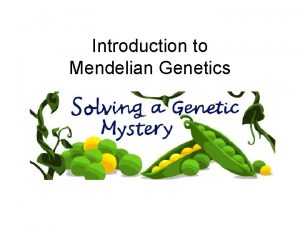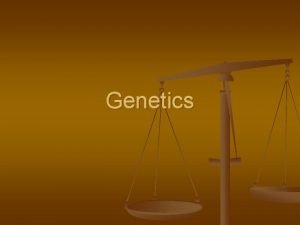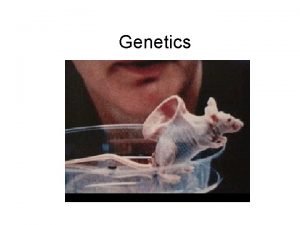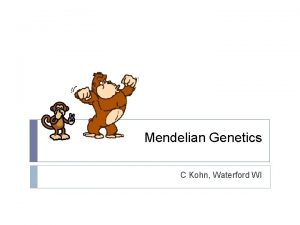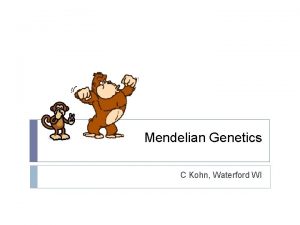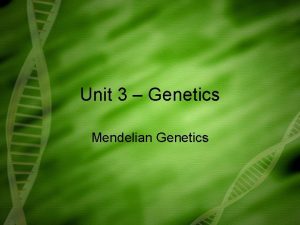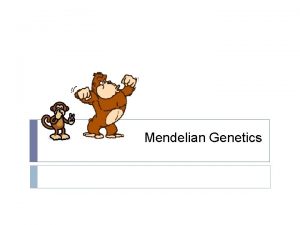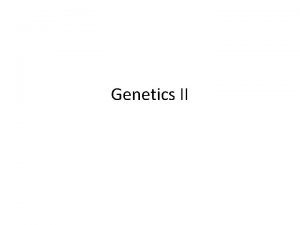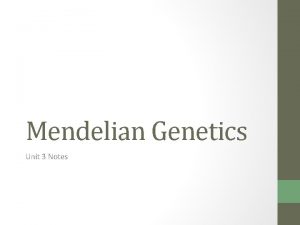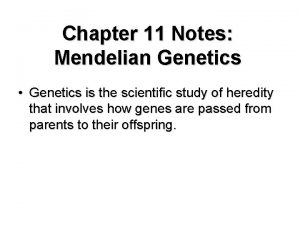Mendelian Genetics Meiosis I Meiosis II Meiosis Notes












































- Slides: 44

Mendelian Genetics Meiosis I & Meiosis II

Meiosis – Notes B-4. 5 n The process of meiosis and its importance to sexual reproduction just as mitosis is to asexual reproduction. n In order for the offspring produced from sexual reproduction to have cells that are diploid (containing two sets of chromosomes, one set each parent), the egg and sperm cells must be haploid (contain only one of each type of chromosome). The division resulting in a reduction in chromosome number is called meiosis. n Meiosis occurs in two steps: ¨ Meiosis II

Meiosis I and Meiosis II Meiosis I, in which the chromosome pairs replicate, results in two haploid daughter cells with duplicated chromosomes different from the sets in the original diploid cell. n Meiosis II, in which the haploid daughter cells from Meiosis I divide, results in four haploid daughter cells called gametes, or sex cells (egg and sperm), with undoubled chromosomes. n

Meiosis n Production haploid cells that are different ¨ N-represents chromosome number ¨ Sperm or egg ¨ Reduction of chromosomes Somatic cells – regular body cells n Germ cells – sex cells n Germ makes sperm!

spermatogenesis 46 Duplicated Chromosomes 92 Chromosomes

Oogenesis

Results? Spermatogenesis - 4 functioning sperm n Oogenesis n – 1 egg, 3 polar bodies n

Meiosis I- Homologous Chromosomes Separate n n Meiosis I begins with interphase, like in mitosis, in which cells: (1) increase in size, (2) produce RNA, (3) synthesize proteins, and (4) replicate DNA Prophase I ¨ The nuclear membrane breaks down; centrioles separate from each other and take up positions on the opposite sides of the nucleus and begin to produce spindle fibers. ¨ Chromosomes pair up and become visible as a cluster of four chromatids called a tetrad. n A homologous chromosome pair consists of two chromosomes containing the same type of genes. ¨ ¨ the paternal chromosome in the pair contributed by the organism’s male parent the maternal chromosome in the pair contributed by the organism’s female parent

Meiosis I- Prophase I ¨ Each chromosome consists of two sister chromatids attached at a point called the centromere. ¨ Because the homologous chromosome pairs are in close proximity, an exchange of chromosome genetic material between pairs often occurs in a process called “Crossing over. ”

n Meiosis I ¨ Prophase I – homologous chromosomes come together, form tetrad (4 chromo) Crossing over – exchange portion of chromosome n Synapsis n Independent assortment n ¨ Meta I, Ana I, Telo I, Cyto I

Meiosis I- Other Phases Metaphase I n Anaphase I n Telophase I n Cytokinesis Product: 2 Haploid Daughter Cells n ¨ Each of the two daughter cells from meiosis I contains only one chromosome (consisting of two sister chromatids) from each parental pair. Each daughter cell from meiosis I proceeds to undergo meiosis II.

Meiosis II- Sister Chromatids Seperate

Meiosis II- Sister Chromatids Separate NO INTERPHASE! Why? n Prophase II n Metaphase II n Anaphase II- sister chromatids pulled apart n Telophase II n Cytokinesis n Product- 4 Genetically Diverse Haploid Daughter Cells

Turn & Talk Mitosis vs. Meiosis n Similarities? n Differences? End Product of Mitosis? n End Product of Meiosis? n What does this tell us about Genetic Diversity? n

Let’s Make a Foldable Meiosis I & II ¨ Turn to page 174 and 175 in book and/or get i. Pad ¨ Materials : Two Sheets of 8’x 11” Paper, Colored Pencils, Markers, Book, i. Pad ¨ Rubric Must have ALL (8) the Phases of Meiosis I and Meiosis II (PMAT I & PMAT II) Must have a correct descriptions and drawings Must include why there is no interphase between Meiosis I and Meiosis II Must copy and answer the Essential Questions

Essential Questions Answer on Foldable 1. 2. 3. 4. Does Mitosis or Meiosis occur more frequently in your body? Explain. List two differences AND two similarities between Mitosis and Meiosis. Are homologous chromosomes identical to each other? Explain. Why is it important that gametes are haploid cells?

The Work of Gregor Mendel Video n http: //www. cleanvideosearch. com/media/action/ yt/watch? video. Id=2 Uu. SLDv. PZn. U n

Work of Mendel Studied 7 traits of pea plants (pg 179) n Pea Shape, Pea Color, Flower Color, Pod Shape, Pod Color, Flower Position, Plant Height ¨ His Process n Since most plants are selfpollinating, he wanted to manipulate the fertilization. n Mendel controlled fertilization of pea plants by removing the male parts of stamens, then fertilizing the female part (pistil) with pollen from a different plant ¨

Mendel came to 2 conclusions after the breeding 1. 2. Genes, segment of DNA, occurs in pairs, controll heredity. Visual form called alleles. (noted as “factors”) Found that some of the alleles are dominant and some are recessive. Dominant trait always uppercase (TT, Tt) 2. Recessive always lowercase (tt) 1.

Notes B-4. 6 n n n Genetics is the study of patterns of inheritance and variations in organisms. Genes control each trait of a living thing by controlling the formation of an organism’s proteins. Since in all cells (except gametes) chromosomes are diploid (exist as a pair of chromosomes), each cell contains two genes for each trait, one on the maternal chromosome and one on the paternal chromosome. The two genes may be of the same form or they may be of different forms. The different forms of a gene are called alleles. These are the Letters!!! TT, Tt The two alleles are segregated during the process of gamete formation (Law of Segregation)

Law of Dominance States that some alleles are dominant whereas others are recessive. n When an organism has two identical alleles for a particular trait that organism is said to be homozygous for that trait. n When an organism has two different alleles for a particular trait that organism is said to be heterozygous for that trait. n Question: What are alleles?

Genotype vs. Phenotype n Study Tip! What does the word “genotype” look like? What does the word “phenotype” look like? Genotype Phenotype The genotype (genetic makeup) of an organism reveals the type of alleles that an organism has inherited for a particular trait. • TT represents a homozygous dominant genotype. • tt represents a homozygous recessive genotype. • Tt represents a heterozygous genotype. The phenotype (physical characteristics) of an organism is a description of the way that a trait is expressed in the organism. • Organisms with genotypes of TT or Tt would have a phenotype of tall. • Organisms with a genotype of Tt would have a phenotype of short.

Project Time! Bunny Genetics (25 mins) n n n Obtain a paper bag and a handout for Bunny Genetics. Design your Bunny. Use markers and colored pencils. Fill out the chart with the correct Phenotypes & Genotypes

Law of Segregation n The law (principle) of segregation explains how alleles are separated during meiosis. Each gamete receives one of the two alleles that the parent carries for each trait. Each gamete has the same chance of receiving either one of the alleles for each trait. During fertilization (when egg and sperm unite), each parent organism donates one copy of each gene to the offspring producing a diploid zygote.

Law of Independent Assortment n n Dihybrid Cross The law of independent assortment states that the segregation of the alleles of one trait does not affect the segregation of the alleles of another trait. Genes on separate chromosomes separate independently during meiosis. This law holds true for all genes unless the genes are linked. In this case, the genes that do not independently segregate during gamete formation, usually because they are in close proximity on the same chromosome.

The F 1 Cross n F 1 =First Filial (parent cross produce the F 1 then cross the F 1 making an F 2) ¨ Law of segregation: Segregation of alleles occurs during the formation of gametes, sex cells. ¨ Law of Independent Assortment – factors for individual characteristics are not connected. Assort independently of each other.

Punnett Squares A Punnett square can be used to predict the probable genetic combinations in the offspring that result from different parental allele combinations that are independently assorted. n • A monohybrid cross examines the inheritance of one trait. The cross could be homozygous-homozygous, heterozygous, or heterozygoushomozygous. n

Punnett Squares n Punnett square – table representation of crossing alleles ¨ REMEMBER…. ¨ TT or tt – homozygous – same alleles ¨ Tt – heterozygous – different alleles ¨ Phenotype – physical look, all tall (TT, Tt) have same phenotype. ¨ Genotype – based on alleles. (TT, and Tt) are different now.

n n n n n Dominant Curled Up Nose Clockwise Hair Whorl Can Roll Tongue Widow's Peak Facial Dimples Able to taste PTC Earlobe hangs Middigital hair (fingers) No hitchhiker's thumb Tip of pinkie bends in Oval face Cleft chin Broad eyebrow Separated eyebrows Long eyelashes Almond eyes Freckles Wet-type earwax Left thumb on top of interlocking fingers Recessive Roman Nose Counter-clockwise Hair Whorl Can't Roll Tongue No Widow's Peak No Facial Dimples Unable to taste PTC Earlobe attaches at base No middigital hair Hitchhiker's thumb Pinkie straight Square face no cleft chin Slender eyebrow Joined eyebrows Short eyelashes Round eyes No freckles Dry-type earwax Right thumb on top of interlocking fingers


Probability Penny = ½ =. 50 n A cross results in 787 pink flowers and 277 white flowers. If we cross the same P generation, the probability will be the same) n

Homozygous x Homozygous (YY x yy)

Homozygous x Heterozygous (AA x Aa) a AA x Aa A n A Aa AA AA

Heterozygous x Heterozygous (Bb x Bb)


Dihybrid cross – two traits

Lets Practice Punnett Squares!! We can do some together as practice, then work independently on Bunny Project with a partner.

B-4. 7 Notes n Chromosome theory of inheritance is a basic principle in biology that states genes are located on chromosomes and that the behavior of chromosomes during meiosis accounts for inheritance patterns, which closely parallels predicted Mendelian patterns. n Gene linkage simply means that genes that are located on the same chromosome will be inherited together. These genes travel together during gamete formation. ¨ This is an exception to the Mendelian principle of independent assortment because linked genes do not segregate independently.

n Crossing-over is a process in which alleles in close proximity to each other on homologous chromosomes are exchanged. This results in new combinations of alleles. ¨ When chromosomes pair up during meiosis I, sometimes sections of the two chromosomes become crossed. The two crossed sections break off and usually reattach. Question: What phase of Meiosis does crossing over occur?

n n Incomplete dominance is a condition in which one allele is not completely dominant over another. The phenotype expressed is somewhere between the two possible parent phenotypes. Red x white = pink Codominance occurs when both alleles for a gene are expressed completely. The phenotype expressed shows evidence of both alleles being present. Red x White = both red and white

What’s this?

What’s this?

n Multiple alleles can exist for a particular trait even though only two alleles are inherited. For example, three alleles exist for blood type (A, B, and O), which result in four different blood groups. n Polygenic traits are traits that are controlled by two or more genes. These traits often show a great variety of phenotypes, e. g. skin color

 Difference between mendelian and non mendelian inheritance
Difference between mendelian and non mendelian inheritance 11-3 exploring mendelian genetics answers
11-3 exploring mendelian genetics answers The scientific study of heredity *
The scientific study of heredity * Codominance example
Codominance example Section 11-3 exploring mendelian genetics
Section 11-3 exploring mendelian genetics Mendelian genetics vocabulary
Mendelian genetics vocabulary Section 11-3 exploring mendelian genetics
Section 11-3 exploring mendelian genetics Mendelian principles of genetics
Mendelian principles of genetics 11-3 exploring mendelian genetics answers
11-3 exploring mendelian genetics answers Section 11-5 linkage and gene maps answer key
Section 11-5 linkage and gene maps answer key Codominance alleles
Codominance alleles Hors xnxn
Hors xnxn 11-3 exploring mendelian genetics
11-3 exploring mendelian genetics Chapter 10 section 2 mendelian genetics answer key
Chapter 10 section 2 mendelian genetics answer key Mendelian genetics
Mendelian genetics Holandric genes
Holandric genes Introduction to mendelian genetics
Introduction to mendelian genetics X-linked recessive punnett square
X-linked recessive punnett square Incomplete dominance definition
Incomplete dominance definition Chapter 7 extending mendelian genetics
Chapter 7 extending mendelian genetics Mendel was a
Mendel was a Purebred vs hybrid
Purebred vs hybrid Pprr x pprr punnett square
Pprr x pprr punnett square Mendelian genetics concept map
Mendelian genetics concept map Chapter 7 extending mendelian genetics answer key
Chapter 7 extending mendelian genetics answer key Codominant
Codominant Sexual reproduction and genetics section 1 meiosis
Sexual reproduction and genetics section 1 meiosis Section 1 meiosis
Section 1 meiosis Mendelian randomisation
Mendelian randomisation Recessive epistasis
Recessive epistasis Mendelian traits
Mendelian traits Difference between mendelian and chromosomal disorders
Difference between mendelian and chromosomal disorders Non mendelian law
Non mendelian law Mendelian ratios
Mendelian ratios Mendelian
Mendelian Mendelian dihybrid test cross
Mendelian dihybrid test cross Postulat mendel
Postulat mendel Mendel's law of inheritance
Mendel's law of inheritance Non mendelian law
Non mendelian law Non mendelian inheritance
Non mendelian inheritance Baldness genotype
Baldness genotype Mendelian traits
Mendelian traits Probability laws govern mendelian inheritance
Probability laws govern mendelian inheritance Homozygous
Homozygous Cystic fibrosis mendelian inheritance
Cystic fibrosis mendelian inheritance
